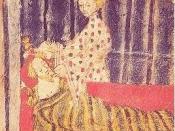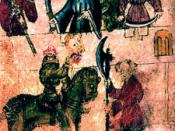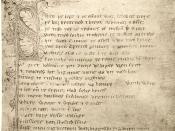According to Aristotle, there are two distinct types of language: Those that entertain, and those that educate. Entertainment comes from literature that provides pleasure and delight, such as poems. Education comes from works that offer instruction and explanation, for example, rhetorical pieces. In spite of how true this seems, it oversimplifies writing, and it has clearly been proven during this unit that poetry has the ability to both entertain and educate. Within each poem read during this Poet Unit, there is a truth, or moral embedded in the story, yet it is how this truth is revealed that entertains the reader. In "Sir Gawain and the Green Knight", the truths of chivalry, honesty, innocence, and courage are conveyed, but it is its use of conflict, symbols, and imagery that makes this a cunning piece of poetry.
Although all stories present a conflict, the poems in this unit use those situational conflicts to further the meaning of its truth.
One definitive conflict in "Sir Gawain and the Green Knight" is when the Green Knight arrives at King Arthur's court to challenge one of his men to a game in the spirit of Christmas, in which he must agree to accept one blow of his axe, after having the chance to give one to the Green Knight. This offer proves to entice few contenders, which surprisingly contrasts with what one would think of a chivalric knight of the round table. Though one young challenger does step up, Sir Gawain, nephew of King Arthur. This honorable action by Gawain as a response to the conflict presented by the Green Knight demonstrates the truth of chivalry and the will to do anything possible to protect the king, no matter how dangerous. Another challenge displayed in "Sir Gawain and the Green Knight" is...


